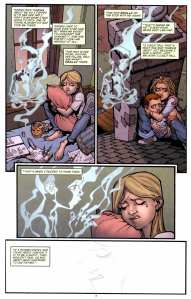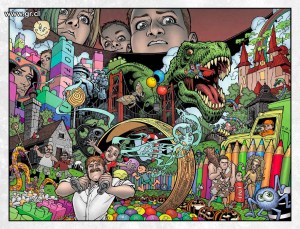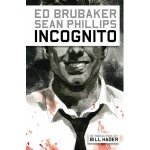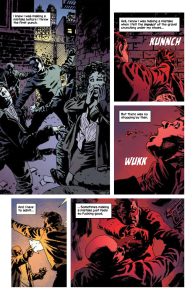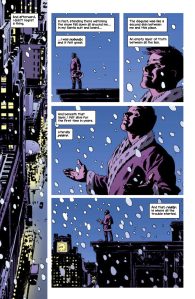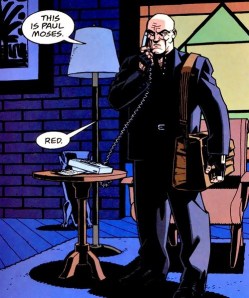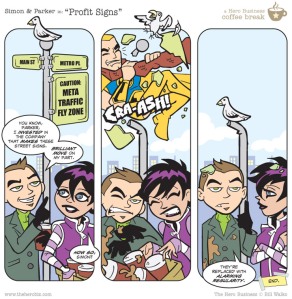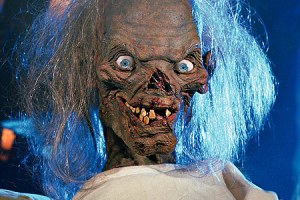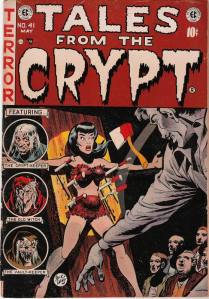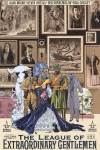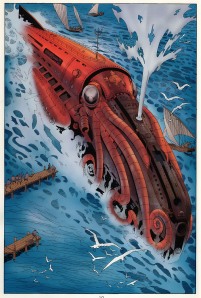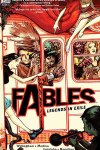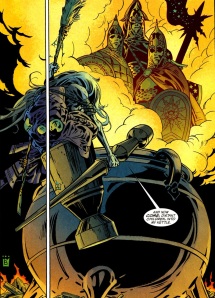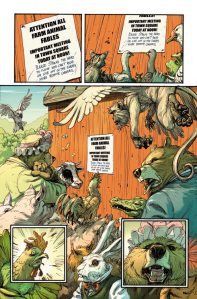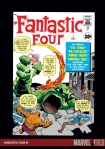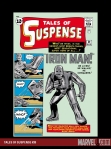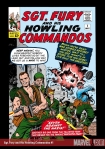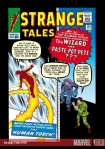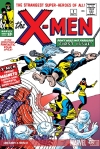 Ongoing Series. Collections available from Amazon(US) or Amazon(UK).
Ongoing Series. Collections available from Amazon(US) or Amazon(UK).
Publisher: Image (formerly Devil’s Due)
Writer: Tim Seeley
Artists: Emily Stone, Stefano Caselli, Dave Crosland, Skottie Young
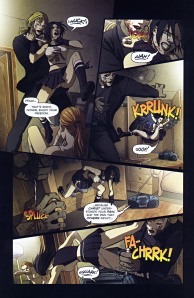 Starting out as a collection of one-shots (standalone stories) before evolving into an ongoing series, Hack/Slash is the tale of Cassie Hack. Cassie’s teenage years were marred somewhat by the two killing sprees launched into by her overprotective mother, posthumously known as the Lunch Lady. The moniker comes from the fact that she murdered Cassie’s bullying classmates and then fed them to the remaining student body. And she was a lunch lady. Eventually Cassie was forced to kill her mother, because even her own boiling gravy-based suicide wasn’t enough to stop her murderous rampage. Joined by Vlad – a gasmask-wearing, deformed giant often mistaken for a monster himself – an older and more badass Cassie embarks on a crusade to rid the world of the slasher menace.
Starting out as a collection of one-shots (standalone stories) before evolving into an ongoing series, Hack/Slash is the tale of Cassie Hack. Cassie’s teenage years were marred somewhat by the two killing sprees launched into by her overprotective mother, posthumously known as the Lunch Lady. The moniker comes from the fact that she murdered Cassie’s bullying classmates and then fed them to the remaining student body. And she was a lunch lady. Eventually Cassie was forced to kill her mother, because even her own boiling gravy-based suicide wasn’t enough to stop her murderous rampage. Joined by Vlad – a gasmask-wearing, deformed giant often mistaken for a monster himself – an older and more badass Cassie embarks on a crusade to rid the world of the slasher menace.
Anyone who has grown up since the Eighties will probably be familiar with the concept of slashers, as their kind were the stuff of nightmares – literally, in the case of a certain Mister Krueger – for many a child who engaged in ill-advised late-night TV or VHS run-ins with the likes of Jason Vorhees or Michael Myers. In the Nineties, Kevin Williamson and Wes Craven reinvigorated and dissected the slasher movie with Scream. Today, generally inferior remakes or replicas are still churned out every October to cash in on the chill-seeking Halloween crowd.
If you’ve somehow missed all this and are completely unfamiliar with the horror sub-genre, you’re likely to miss out on a lot of what makes Hack/Slash so much fun, but in the interest of inclusionism we’ll explain the basics. Slashers, or Revenants as they are also known in the comic, are basically mass murderers and serial killers, full of rage, usually psychotic and often possessing some supernatural element that keeps them killing long after they themselves should be dead. They are occasionally able to operate in a community for some time before their deeds come to light, but the favoured approach of the slasher is usually to shun subtlety in favour of gruesome bloodbaths.
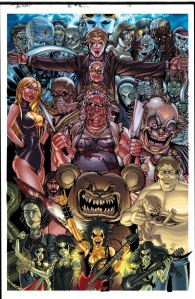 Hack/Slash revels in all aspects of its genre playground – masked, hulking brutes who punish fornicators, a killer doll, a demon-worshipping rock band that sacrifices virgins in exchange for fame, a killer who stalks and strikes in the dreams of his victims, buxom girls running around in ill-fitting clothes – it’s all in there. Even the notion of sequels is tackled with invention and humour, with defeated enemies returning from beyond the grave several issues later or the masks of fallen slashers being taken up by kindred spirits.
Hack/Slash revels in all aspects of its genre playground – masked, hulking brutes who punish fornicators, a killer doll, a demon-worshipping rock band that sacrifices virgins in exchange for fame, a killer who stalks and strikes in the dreams of his victims, buxom girls running around in ill-fitting clothes – it’s all in there. Even the notion of sequels is tackled with invention and humour, with defeated enemies returning from beyond the grave several issues later or the masks of fallen slashers being taken up by kindred spirits.
But for all the gore, titillation and guilty pleasures packed into the pages, Seeley also manages to exploit the relationships between our heroes and the band of helpers they acquire through their adventures for some genuinely touching emotional beats. Despite their almost super-human stance against the terrors of the world, Cassie and Vlad, and their friends, are still human (probably). As such, they periodically require comfort, sympathy or the occasional break from all the eviscerating and disembowelling. By remembering to show us these chinks in the armour of his leads, Seeley makes them more than just two-dimensional monster-hunters. And he compels the reader to join these characters on each new step of their slasher-bashing mission.

